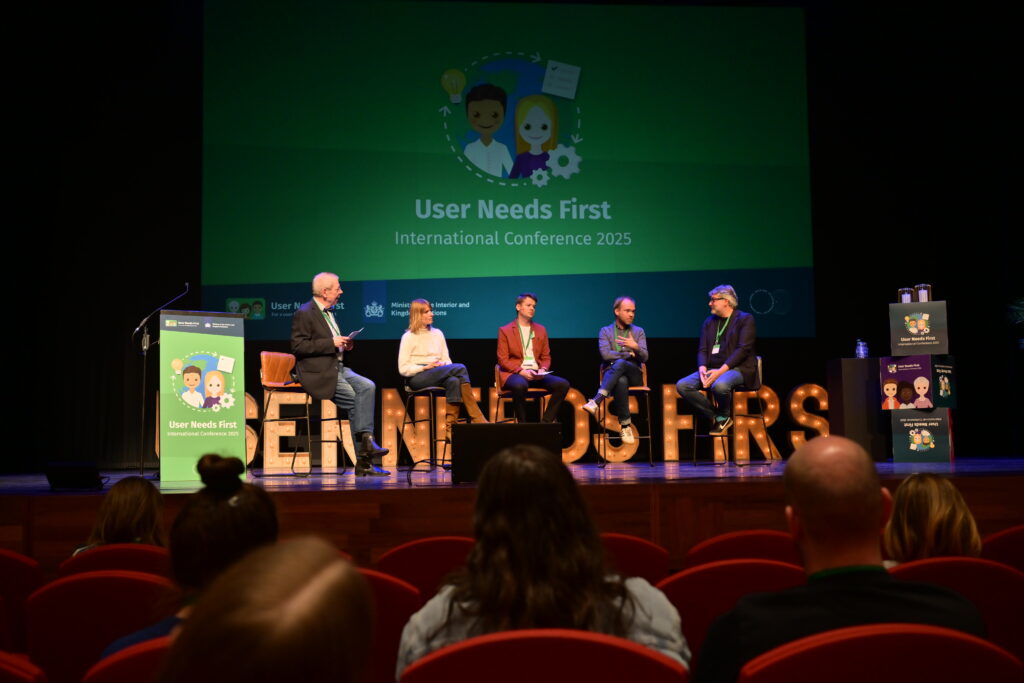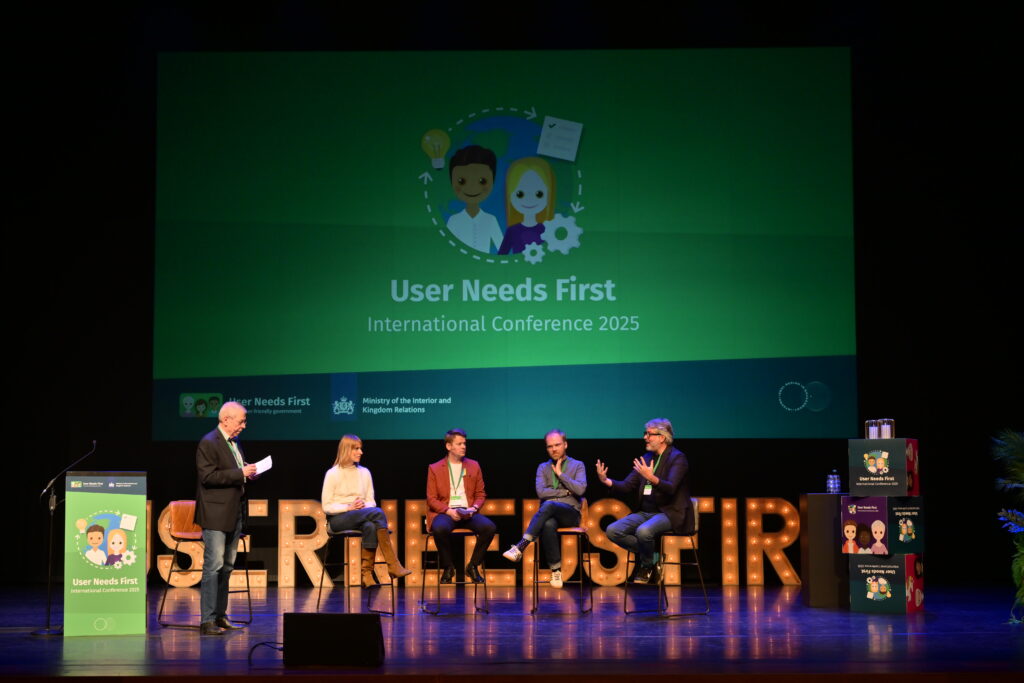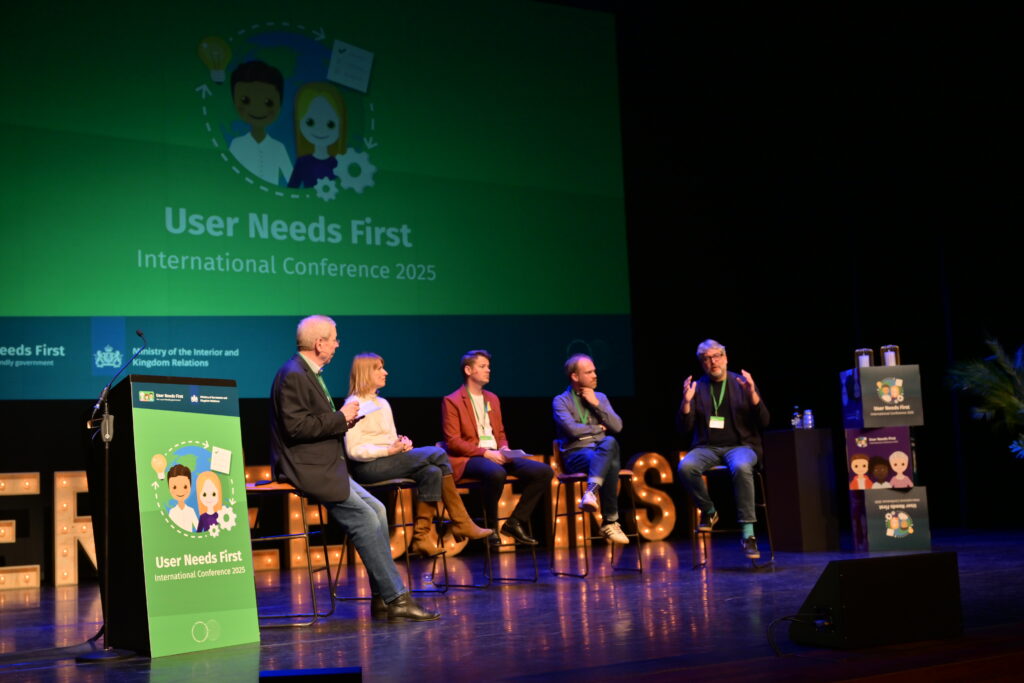‘A good digital government isn’t a sprint – it’s a conversation’
What does a truly inclusive digital government look like? That was the central question driving one of the breakout sessions at the User Needs First International Conference 2025.

Set up as a dynamic panel discussion, the session brought together a diverse group of voices, led by moderator Harry van Zon, former director general, Dutch national government.”
The panel featured:
- Charlotte Vorbeck, UX designer at Germany’s Digital Service
- Marten Jakobson, advisor at the Estonian Ministry of Justice and Digital Affairs
- Maurits Ippel, strategic advisor at the Dutch National Ombudsman
- Jake Blok, co-founder of the Digital Rights House and tech entrepreneur
Together, they explored the complex tension between digital ambition and real-world accessibility. Drawing on international perspectives, practical experiences, and open debate.
Not everyone wants (or can use) digital services
Jake opened with a clear warning: “I love technology, but the pace of digitalisation can be exclusionary.” People without internet access, with visual impairments, or who struggle with language can quickly fall through the cracks. Accelerating digital services without thoughtful design can deepen inequality – and erode trust.
Maurits, speaking from his experience at the National Ombudsman, emphasized the difference between internal government systems and citizen-facing services. “Digitizing the backend is one thing. But the moment you exclude people from accessing services because they lack skills or devices, you’re creating a new kind of inequality.”
Fix the backend first? Not always
Should a government digitize internal systems before offering digital access to citizens? Marten argued yes: backend chaos makes digital delivery impossible. But Charlotte shared the German experience: “Even with paper-based backends, providing digital access can still save people a trip to city hall.” In other words: pragmatism matters.

From multi-channel to omni-channel: Put the user in control
Despite being one of the world’s most digital public administrations, Estonia still relies on a multi-channel approach – online, paper-based, and in-person – to reach everyone. However, Marten clarified that some services in Estonia are digital-only, such as applying for Estonian e-residency, registering a public limited company, or employment registration. In many other cases, non-digital alternatives exist, but they are often underused or discouraged due to their complexity for all parties involved.
One audience member advocated for an omni-channel model instead: where citizens can pick the channel that best suits their situation. “All channels should be equally well-designed and accessible.” Maurits agreed: “That’s also the official policy in the Netherlands. Communication must follow the citizen’s lead.”
The aging population isn’t a side note – it’s the core challenge
A public sector innovation researcher in the audience raised a crucial point: “We treat older people as a minority, but we’re all aging. Older adults will soon be the majority – and systems need to reflect that.”
Countries like Germany face staff shortages and service pressures that make analogue delivery less and less feasible. Smart, inclusive digitalisation is no longer optional – it’s survival.
Jake reinforced this: “This isn’t just about older people. It’s about anyone who needs more support. A way to design digital systems more user first is to set up citizen beta testing programs. Experimenting on people needs to include citizen listening.”

Trust can’t be designed into an interface alone
Digital trust doesn’t come from a sleek UI – it comes from transparency, clear rights, and strong institutions. Jake posed a critical question: “Who represents me in a fully digital world?” Without watchdogs like the Ombudsman or legal safeguards, citizens are left exposed.
Marten added that trust is eroded daily by the growing gap between user-friendly private sector services (like banking apps) and clunky public ones. “Digitalization is essential, but it must close that trust gap.”
A birth, a death, or applying for help — these are not transactions. They’re human moments
Government services are not supermarket products
Moderator Harry put it plainly: “A birth, a death, or applying for help — these are not transactions. They’re human moments.”
Maurits explained that governments don’t operate in a market. Their mission is to deliver public value: fairness, accessibility, and clarity. But that doesn’t mean governments can’t borrow tools from business – like ‘customer journeys’, reimagined as citizen journeys.
Jake introduced a compelling concept: government services should be conversations, not just clicks. “We shouldn’t design seamlessness for its own sake. Sometimes friction signals meaning.” A smooth form submission may be efficient, but a thoughtful pause or prompt can make citizens feel seen and heard.
When privacy and accessibility clash: Rethinking data use
The panel also touched on a thorny issue: metadata. Public documents often have metadata stripped for privacy reasons, but that can make them harder to find or understand.
Jake proposed the idea of a Person Data Stack: all data, from metadata to personal records, is ultimately linked to individuals. So how do we manage data in ways that protect people and serve them?
Marten noted the irony that people often trust tech companies with their data more than their own government. “Leaks are inevitable,” he said. “We need to be honest about that.”
“A good digital government feels like a conversation, not a transaction.”
2 closing principles everyone could agree on
As the session wrapped up, Harry invited the group to find common ground. The panel and audience converged on 2 key principles:
- There should be no quality gap between digital and non-digital services, from the citizen’s perspective.
- Not every service must exist on every channel, but that decision must be intentional and justified.
This wasn’t a session about stopping digital transformation. It was a call to do it better, with care, equity, and people at the centre.
Because in the end, as Jake said: “A good digital government feels like a conversation, not a transaction.”
